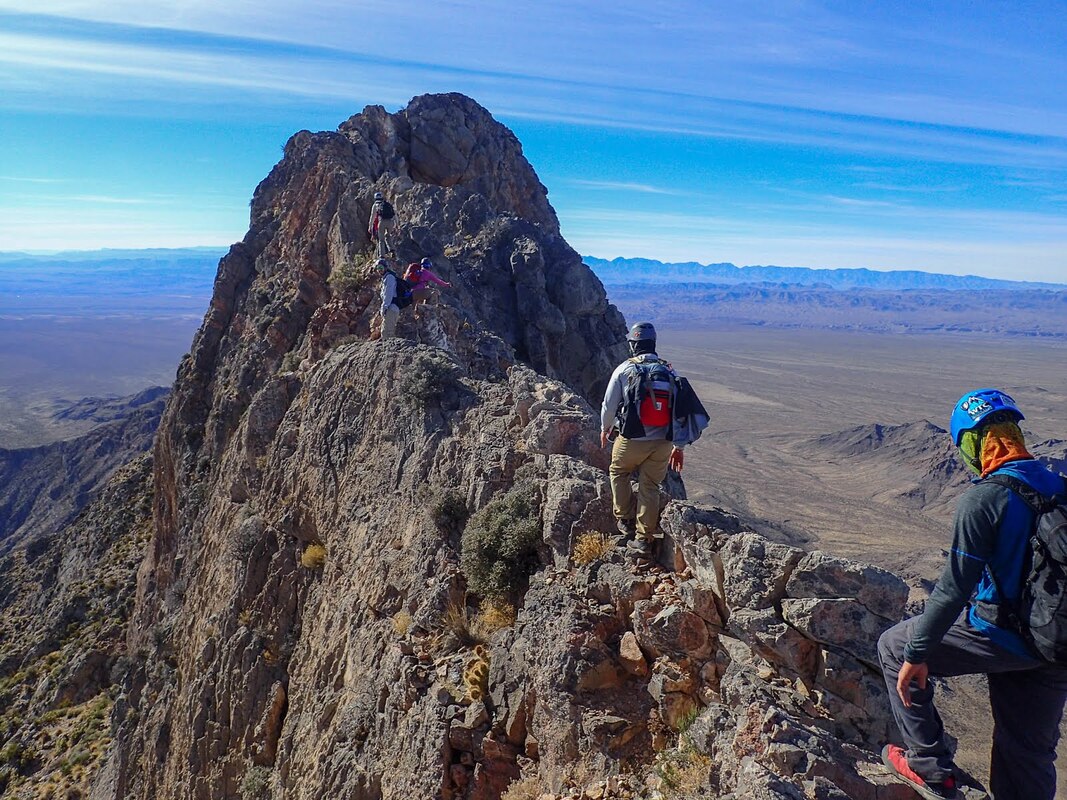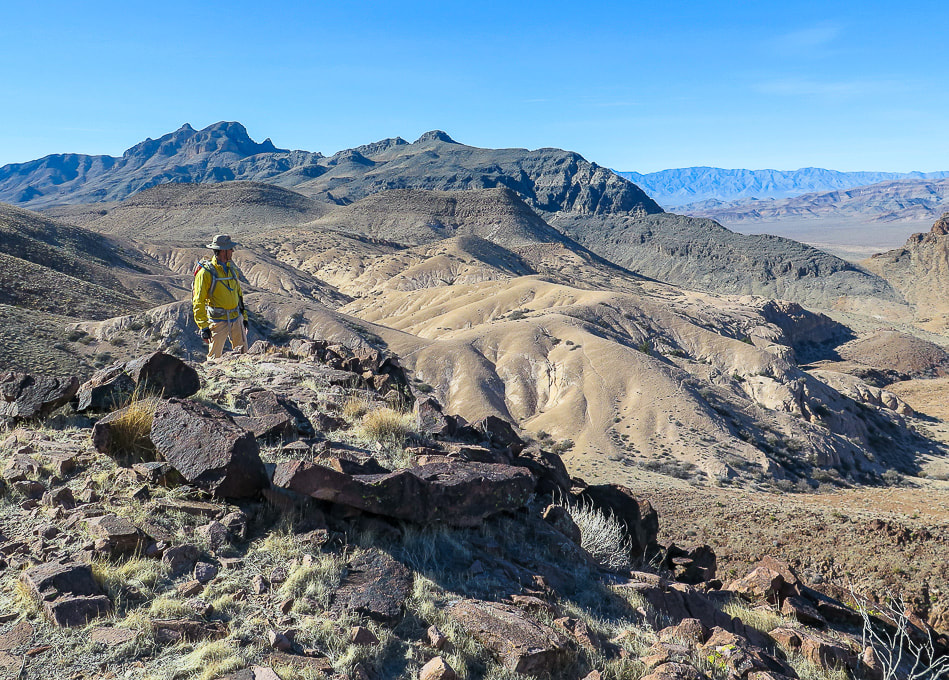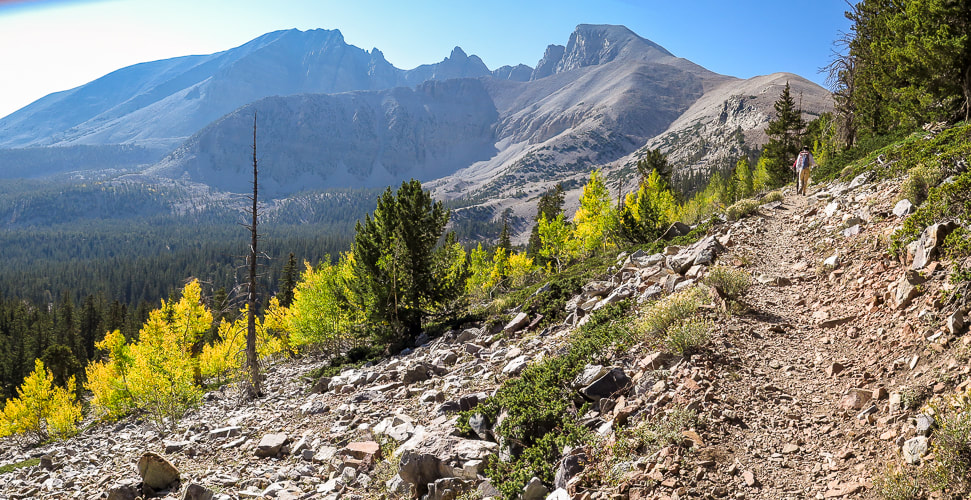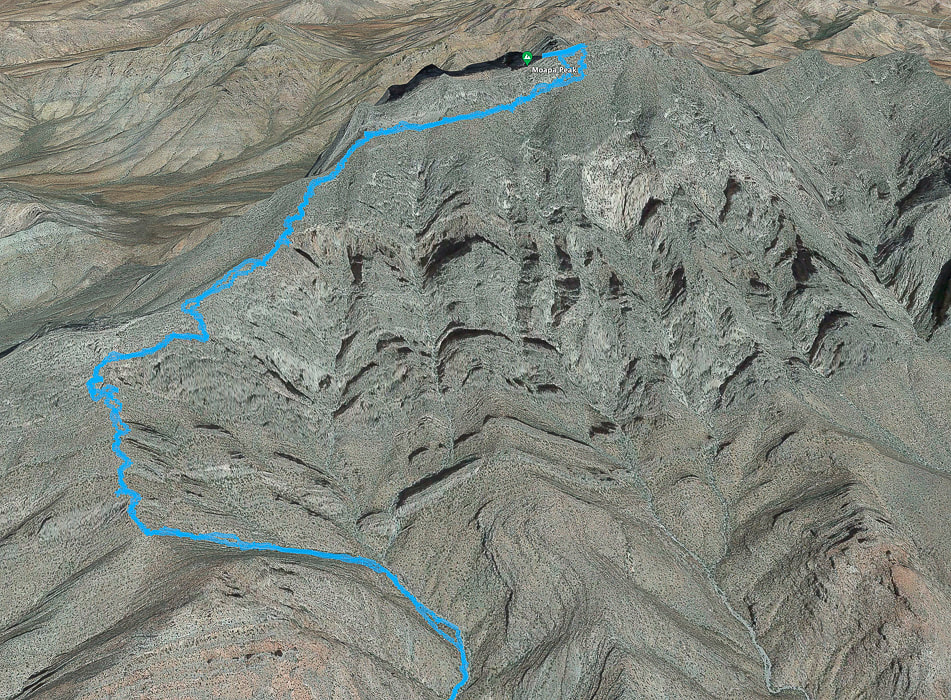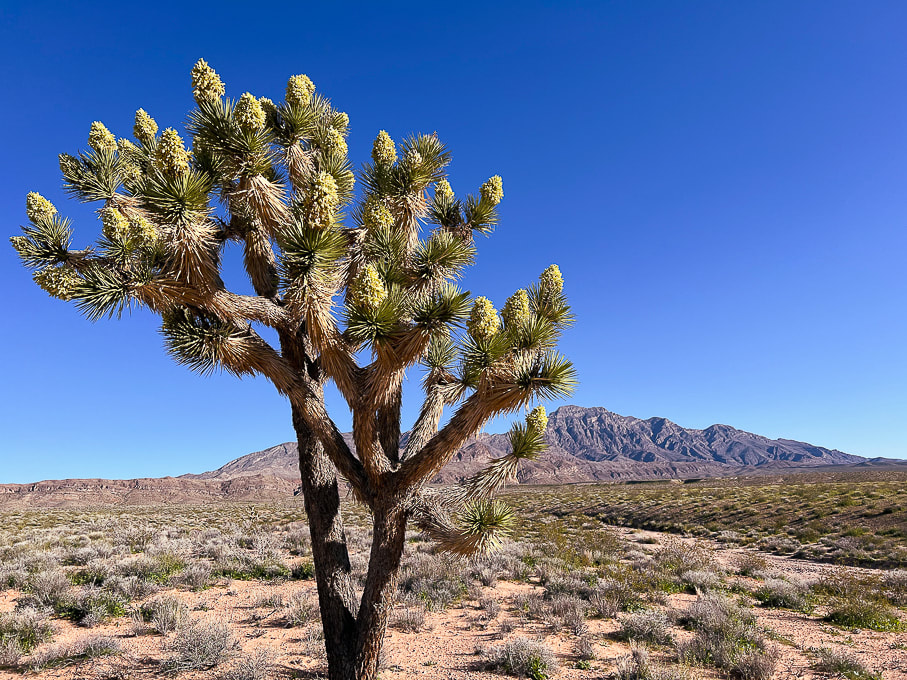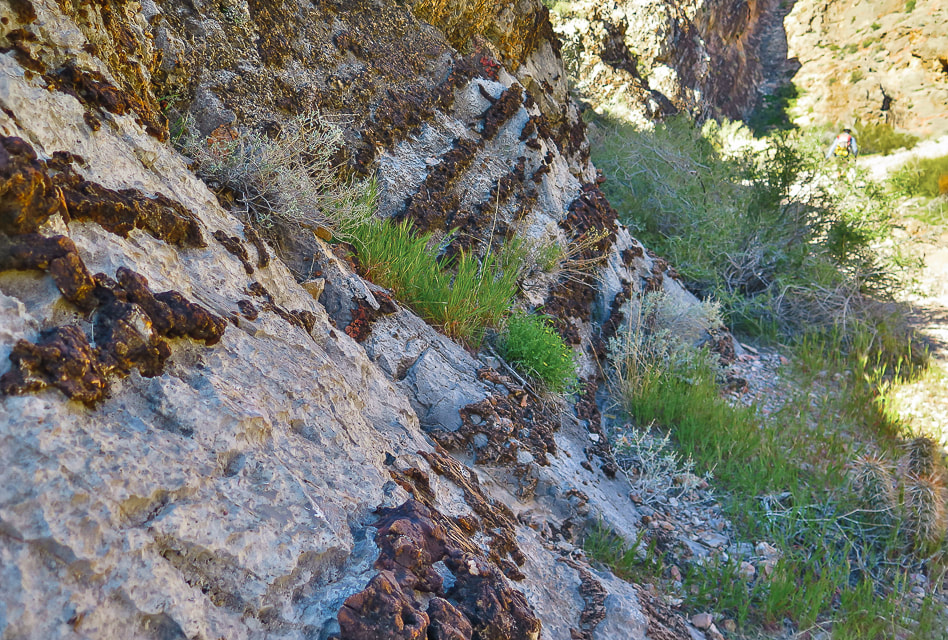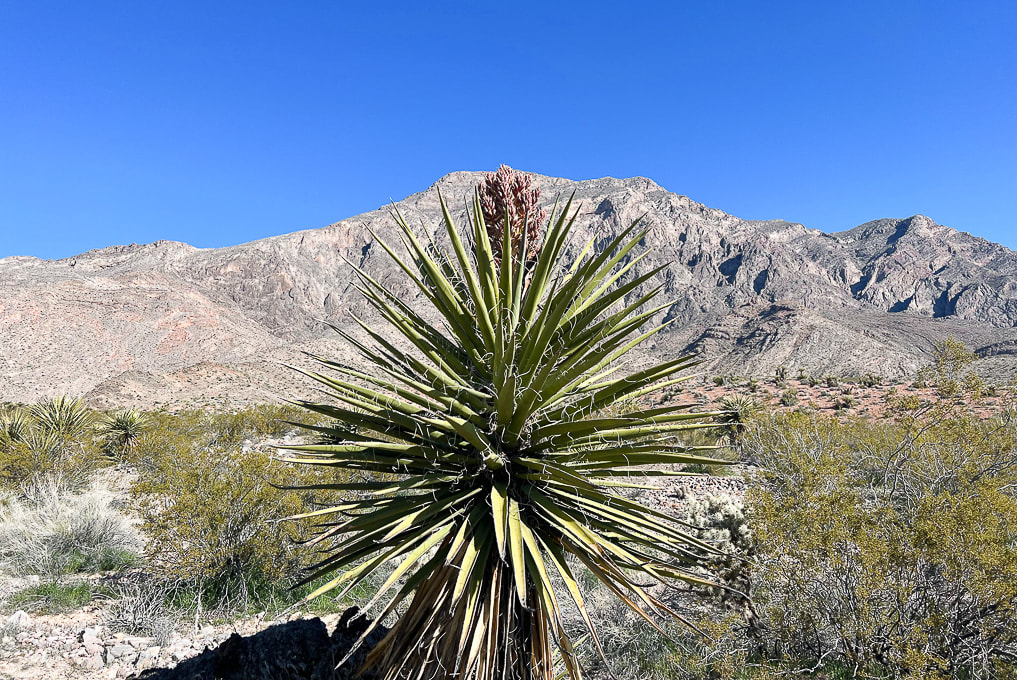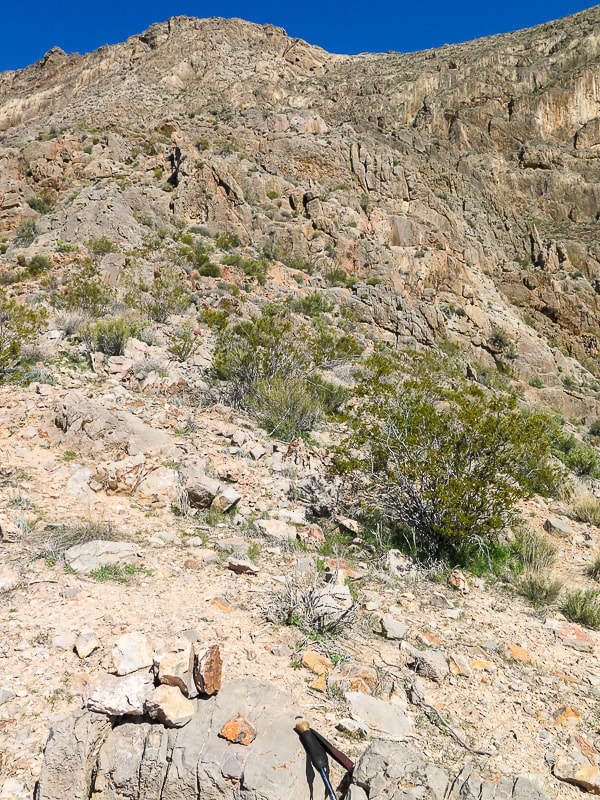|
We met our match on Moapa Peak's fabled "knife edge" final ascent, and came within 160 feet of the summit. Left photo: the final ridge to Moapa's summit. We climbed 3,200' to the high point in the foreground (seen just under the summit in photo), then turned around because this knife's edge seemed too exposed. Right Photos: knife edge from The First Church of the Masochist website, whose party made the summit. Trip Stats
Overview: An enormous gray fin sticking out of the desert floor, Moapa Peak's knife-edge ridge tests the hiker's fear-of-heights-and-exposure factor. Ascend a pretty braided stream wash and then prepare for a steep, rugged climb over sharp limestone the rest of the way, negotiating a few Class 3 rock faces, paying close attention to rock cairns that mark an elusive trail that aggressively elevates you to sneak under Moapa's southern summit block. Gashes, chasms and sheer walls appear as you hike, with spectacular views of the empty desert far below. Descriptions of the final exposed ridge to the top include "exhilirating", "thrilling", and "incredibly fun." Location: Southeast Nevada, Mormon Mountains - Bureau of Land Management. Distance/Elevation gain: Trailhead = 3,134'. Summit = 6,471'. Our hike = 7 miles to 6,310'. To the summit = 7.3 miles. Difficulty/Navigation/Exposure: easy - moderate effort through wash, strenuous Class 2 and Class 3 on cairned trail, moderate to significant exposure (cliff edges or drop-offs 2-3 feet away) on final ridge. Navigation moderately challenging. Coordinates: Trailhead = 36.83395,-114.44132. Summit = 36.85856,-114.45. Date Hiked: April 2, 2023. Prominence: 1,671' Maps and Apps: Stavislost hike report, Bureau of Land Management - Nevada/Overton topo map. Geology: Paleozoic rocks of Mississippian period - 340 mya. Normal faulting due to Great Basin extension. Lists that contain Moapa Peak: Las Vegas Mountaineers Classics (rank #46), Sierra Club Desert Peaks Section (#52). History: Moapa Valley, south of Moapa Peak is famous for the cantaloupes it produces from its farmlands. Native American word "Mo-a-pa" means a valley or canyon with a large stream of water flowing through it. Related Posts:
Our GPS tracks from narrow point of wash (bottom) to near Moapa Peak's summit. Out of the wash, the trail climbs to saddle (lower left), then ascends over rock ledges, some of them Class 3, continues along southern base of summit block, then curves around at base of final ridge to summit. more GPX track maps at end of this post Moapa Peak, included on the Sierra Club Desert Peaks Section list is a distinguished, stand-alone hulk of narrow limestone noticeable on the north side of I-15 north of Las Vegas. It's a classic desert peak, well-fortified by a series of almost vertical ramparts at its base. It's one of the more memorable and exposed hikes I've done. Trip reports reveal hikers who have summited, as well as those who reportedly turned around when they saw the final exposed "knife-edge" ridge to gain the last 160'. After skirting around the south cliff face, the route wraps briefly to the north at a saddle, where the Class 3 climbing up the final ridge begins. Although the narrow ridge proved too daunting for Fred and I, the hike was worthwhile because the steep drop-offs give the slight feeling that a few missteps may plunge you into the chasms and canyons below. We found the "trail" mostly stable and easy to follow. The views of the ribs of dark and sharp mountain ranges rising from flat and buff-colored desert washes are spectacular. Occasional fossils appear in this Paleozoic limestone (see photos below). I'm not sure what they are, so if someone knows, please contact me! One of them looks like fish, another looks like petrified wood. Harder than Mt. Katahdin's knife edge? Maine's Mt. Katahdin, it's highest, has a famous "knife's edge" traverse to the summit. Fred and I summited Katahdin when we lived in New England and felt it wasn't too scary. Reports say that it narrows to four feet of width in a few places. I think Moapa Peak, which reportedly narrows to one foot, is more intimidating. Side note: Mt. Katahdin is the northern terminus for the Appalachian Trail. While we were on the summit, we saw a hiker who had just completed the entire trail arrive at the famous terminus sign. I'll never forget the look on his face! Some of his family was there to greet him. Hike Summary
I would avoid doing this hike in the summer months. I know from experience, since we roasted on this hike last summer and turned around at the saddle because of the heat and intense sun. This is a unique hike that not many get to experience. This beautiful mountain won't make it easy for you to gain its summit, or even get to its approach ridge. The Nevada desert is stark and hard and the limestone unforgiving. And, the only flat spot is found briefly on the saddle above the approach drainage. Fred and I are lucky to be able to explore this exquisite part of the southwest. Now when we see Moapa from I-15, we can see how high we got on that very vertical mountain. Keep on Exploring! Get It While You Can! Driving toward Moapa Peak: Joshua Tree in spectacular bloom after a very rainy and cooler than usual 2022-23 winter. Park near trailhead sign. Start by walking on road that leads to approach drainage. Look at what we get to climb! Road passes by impressive display of layered chert in limestone. Yucca with bloom in wash - heading to low hill on left side of photo. Occasional cairns mark way up braided stream drainage. Drainage narrows. A bit of boulder-hopping and maneuvering as you get closer to head of drainage. Duck on the right boulder. Trail continues left of large dry waterfall - entry to this trail that takes you out of the wash is marked by a cairn. Once out of the wash, everything here is steep! Cairns mark trail that continues up to saddle (top of photo). Getting closer to saddle, then the trail goes up and works around the rock ledges ascending from saddle on the right. Looking back down toward end of wash from the saddle. At saddle, cairns mark trail that ascends the ledges and walls to the north, with some Class 3 climbing. One of the walls to climb to get up over the ledges. The trail continues over these ledges to the less-steep and more open terrain above at top-middle photo. On the ledges section looking back down at the saddle above drainage. The trail ascends to the left of this huge wall. Cairns mark trail as it transitions from the steep ledges to less-steep but narrow "platform". Looking back at relatively flat platform above ledge section. Getting closer to the summit! Walking around south face of summit block. Continuing up toward summit ridge after the walk around south face. Reach Moapa's east ridge for spectacular views to the north - Mormon Mountains. Travel a short distance around Moapa's east ridge to the left to find cairn marking entry onto the final ridge to summit climb. The northwest-facing side of Moapa Peak summit seen here. At first, we missed the cairn to lead us up the walls on the left, so we kept walking along this north side for a short distance. When we didn't see any footprints in the snow here (earlier we met a climber who was on his way down from the peak) and no more cairns, we went back to beginning of the ridge and found the cairn (bottom of photo) marking entry onto the knife's edge part of final ridge ascent. It's here you take a left to find another cairn in the cleft on the left. Making our way back down after turning around at scary knife's edge! A bit disappointed we didn't summit, but still really happy we got that far on this unique hike with its breathtaking views and drop-offs, and steep, narrow approach. Trail comes close to this deep chasm. On the way back heading toward saddle that leads to platform above the ledges section. Snow-covered Virgin Peak in the distance to the east. On the way down: view to the west of Nevada's parallel mountain ranges caused by extension in the Great Basin tectonic province. Great Basin rifting (extension) is the second major tectonic episode that shapes this area; it began ~ 30 mya and continues today. Normal faults result from extension - a pulling-apart of Earth's crust. Tilted sedimentary beds. Nevada is interesting because it has undergone major tectonic forces of mountain building, shearing, faulting and rifting. Descending down the ledges section. Virgin Peak on the horizon. Mojave Prickly Pear Mojave Yucca Some cool stuff on the trail. Our GPX tracks and elevation profile on Caltopo maps. Our GPX tracks walking around Moapa's east ridge and final ascent. The tracks show that initially we went too far along the north face and then we turned around to find the entry to the ridge. References:
Indian Names in Utah Geography. From Utah Historical Quarterly Volume 1, Number 1-4, 1928 by Utah State History. Carpenter, J.A., 1989. Structure of the southern Mormon Mountains, Clark County, Nevada and regional structural synthesis : fold-thrust and basin-range structure in southern Nevada, southwest Utah, and northwest Arizona. Master's thesis dissertation from Oregon State University.
2 Comments
5/2/2023 04:00:23 pm
Yeepers! What an adventure! I'm glad you made it as far as you did and equally glad that you are wise enough to be satisfied with how far you made it.
Reply
Yes, a good word - "wise". Although I still keep on thinking "if I tried again, maybe I could make it! But then Fred and I look at each other and say "nahhh".
Reply
Leave a Reply. |
Categories
All
About this blogExploration documentaries – "explorumentaries" list trip stats and highlights of each hike or bike ride, often with some interesting history or geology. Years ago, I wrote these for friends and family to let them know what my husband, Fred and I were up to on weekends, and also to showcase the incredible land of the west.
To Subscribe to Explorumentary adventure blog and receive new posts by email:Happy Summer!
About the Author
|


